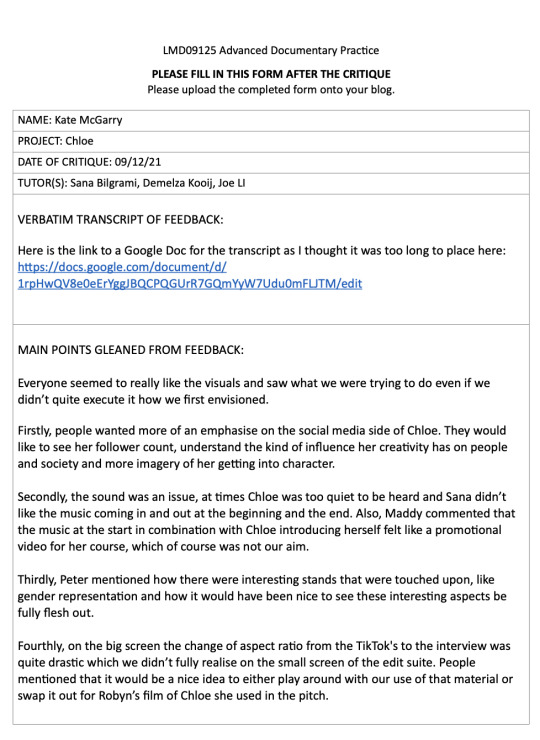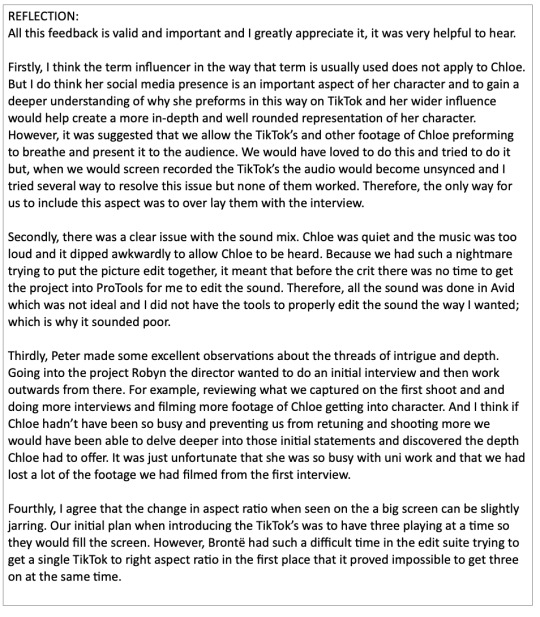Text
Chloe Documentary Sound:
Doing the sound for this project was a bit underwhelming. Going into the project, I had a lot of exciting ideas for the sound, some of which I highlighted in my essay. But unfortunately, all we managed to shoot was the interview, which removed the need to do a lot of detailed sound design.
Location Sound:
Recording sound on set was not recorded how I would have preferred it to be. It was decided to have a paired down crew to make Chlöe feel more comfortable, and because we were travelling a far distance to film logically, it made sense to reduce the amount of equipment we would use. Therefore, we used all of Abigail's equipment during filming, including her LAV mic. We booked a mix pre 3 and shotgun mic on the first shoot day. And at the end of the day, Abigail reviewed the footage and made her case that her lav mic produced good quality sound, so much so that she suggested that we ought not to book out the mix pre 3 again because it adds unnecessarily to the equipment. However, on the subsequent shoots, we had a zoom recorder to record foley, but we also used it as a backup to record interview sound if the lav mic became faulty.
However, when we got into the edit, the sound from Abigail's lav mic was full of static; luckily, we captured the audio on the mix pre 3 for the first interview and the zoom recording for the second. However, on the day of the third interview, Abigail forgot to turn her LAV mic on, but it was fine as we had the zoom recording which I took. But once we got into the edit, those zoom recordings were missing and could not be found. Therefore the footage of our third interview was unusable.
Sound edit:
The picture edit was proving a nightmare and was severely delayed. Therefore, before the crit, I only had the chance to work with Brontë during the picture edit to get some temporary music tracks in the edit and do minor volume automation. However, because I wasn't able to get into ProTools, I couldn't clear up the audio or audio transitions before the crit, but I hope to work on it after and complete the sound for the 13th.
0 notes
Text
Pitches and Tutorials:
After everyone in the class had uploaded their pitches, I watched each one and decided which idea I liked best.
I chose not to work on my idea because I thought logistically it might prove too difficult with tracking Jane down, and she isn't a tech-savvy person, so doing something over facetime wouldn't be feasible.
However, after watching all the pitches, I liked Robyn's idea. I thought Chloe was a fantastic character and the relationship she had with the subject was terrific. Also, I thought the concept of exploring a persons passion through their work was interesting. Costume design has always been an intriguing area of filmmaking that I have always wanted to learn more about.
After the groups were decided, we had a tutorial with Sana, which went well.
Tutoriral Action Form:
NAME: Kate McGarry
Group: Chloe Documentary
Date: 23rd September 2021
Tutors: Sana Bilgrami
Main Points Disscussed a Tutorial:
First, we each expressed why we wanted to work on Robyn's idea.
Abigal: mentioned that she found Chole's relationship with her work and her identity an exciting concept. And she was keen to explore the origins of Chole's passion for costume design and how it has helped her express herself and become more confident.
Dori: expressed that when she saw Robyn's pitch in her mind, she could envision a colourful and vibrant documentary that excited her.
Brontë: said that she has a vested interest in costume design which attracted her to Robyn's idea, and she was really excited about the project.
During the discussion, Sana explained that we needed to constantly ask ourselves questions and interrogating our process to help shape the film's narrative. She noted that it is so important for us to do as much research as possible, speak to Chloe several times and truly understand her and her work. And all this can be extremely helpful when shaping the narrative.
Also, as we spoke, Robyn mentioned that Chloe used to be shy; Sana said it could be a good idea to explore costume design as a medium that has helped form Chloe's identity.
Action Plan with Proposed Dates:
Meet weekly as a group to help stay on the same page as one another.
Arrange dates to meet with Chloe and see her studio.
[Dori] Create a production schedule.
After the tutorial, we met as a group to discuss the project and roles.
Roles:
Robyn - Director
Dori - Producer
Abigal - Cinematographer
Kate - Sound/Camera Assistant
Brontë - Editor
In the meeting, Robyn explained her initial ideas for the documentary. She mentioned that she wanted to explore a couple of Chloe's characters similar to what she had done at the end of her pitch. I thought this was a fascinating idea to bring the characters Chloes creates to life.
After discussing our thoughts and what we each bring to the project, Dori said that she would crack on with some of the production planning. She will create a schedule that will include all the dates of our deadlines across all three modules and will be available to all of us, so we can each input dates in which we will not be available. Therefore, as a group, with have an excellent overview of our ability and will be able to organise ourselves effectively.
Overall, I think we will work really well together as a group, and I am excited to get cracking!
0 notes
Text
Documentary Idea Generation:
After our first documentary lecture, I then got to work to try and find ideas to pitch. Coming up with ideas is always something I struggle with for the documentary module. But I searched through different newspapers to look for inspiration; as I did so, I came across the story about Jane Dotchin.

Jane is a visually impaired 80-year-old woman who takes an annual road trip from her home Nothumbland to the Scottish highlands, but she does it on horseback, which takes her seven weeks. As soon as I saw this story, I immediately read about her story as much as possible. Before I settled on this idea wanted to make sure I could gain access to Jane, and therefore, I emailed the reporter who wrote the story and asked for her contact details. The journalist got back to me quickly and provided me with Jane's mobile number and the number of Jane's friend as apparently she can be difficult to contact. However, I now had access and knew it would be a viable idea, even if logistically it might be tricky.
When I brought the idea class, it seemed to gain quite a good response, and people were interested in Jane's story. Hearing that repose was welcome and gave me a little confidence boost about the idea.
Pitching:

Once in documentary groups, I paired up with Alexa to do my pitch. Before jumping on the call, I whipped a quick script that contained all the information I wanted to convey in my pitch. I thought carefully about all the relevant information, including story elements, approach and access. And then, together, we jumped on a Webex call and sat down to record. When doing the pitches, we were unsure how formal it was supposed to be or whether it was meant to be more of a discussion between us, considering we had been asked to film together. In any case, we pitched our ideas to each other. At first, Webex saved our first recording as a document rather than an mp4. However, we recorded again, and it seemed to work after that.
The only thing I didn't consider was the length of my pitch. I knew that it needed to be two minutes, but I didn't run through my script to check its run, and it wasn't till after the recording that I realised it had run a little long. So I am sorry it ran a little long, and I will do a run-through next time I do a time-limited pitch.
0 notes
Text
Documentary Final Relefcetion:
Exporting:
After I had finished the audio edit, it was then in Alexander's hands to complete the final edit. I must say that it was a big undertaking for Alexander to do all the editing. Under normal circumstance as a group, we would have all had a more active role with the editing, but covid it made editing across several different computers extremely difficult. Alexander had many difficulties with After Effect and wasn't able to create the film titles, so we had to stick with just text on the screen, and some of the pans and zooms of archive footage weren't able to be smoothed out either. Also, having issues with the AFF previously, getting the picture lock into Divinci proved difficult, but Alexander spoke to the technician Alex, and he helped him out. Once the edit was complete, Alexander exported the project and uploaded it to Vimeo, ready for the Crit.
Thoughts on the Final Edit:
Going into the Crit, I felt like the documentary wasn't where it needed to be. There are definitely elements that could be improved, such as replicating how it feels to have the imposter syndrome giving the emotional aspect of the castle story more punch. Thus, making the ending of the film seem more valid. It was hard for us to create additional elements apart from the interview, adding extra layers to the documentary, because we were all separated. We all tried our best to think of ways to make the documentary visually interesting; I created a story inspo document full of suggestions for shot composition for the recreation and other elements for the documentary.
Emily lived with Heather, so all the filming was in her hands; if we had been under normal circumstances, we could have all meet up and be more coordinated about how to shoot the recreations. Also, Heather was resistant to the idea of doing recreations and invading her personal space. Heather wasn't comfortable in front of the camera and very busy when the recreations were shot, so they ended up being very rushed, and they didn't achieve what we wanted them to. Because we had to be so ruthless when constructing the arc for the documentary, it meant that visuals included a lot of jump cuts. We were constantly cutting from the beginning of the interview to the end, taking clips from the middle of the interview, splicing them the clips from the end, etc. In the rough edit, the jump cuts were extremely noticeable, and Alexander it a great job to hide them as much as possible, but in some cases, it was just unavoidable. To hide the cuts, we had to use archive images that were clunky and not ideal; I think we relied too much on of the quality of the recreations, and if we were more organised and not in lockdown, we could have made a more polished documentary.
The Crit:
The Crit was really enjoyable; it was great to see everyone's documentaries. And peoples feedback was helpful too.
Tone:
One of the biggest criticisms in the Crit was the tone of the documentary. People enjoyed the laid back nature of the interview and enjoyed being in the presence of Emily and Heather. However, they noted that there wasn't enough of an emotional through-line to validate the ending. These are all valid remarks. When editing the documentary, one of the things we struggled with the most was the tone. Because the interview was laid back and jovial, even when Heather would talk about difficult experiences she had with the imposter syndrome, they had a humorous undertone. Therefore, we struggled to find that emotional structure without forcing it or making it feel artificial.
Music:
This relates to the last piece of feedback; people commented that the music we used didn't feel appropriate. Cameron commented that the music made it feel less like a documentary and more like an online chat show. Our decision with the music was to continue the tone set by the opening sequence because we felt that it wouldn't make sense to have an upbeat and quirky opening title sequence and then betray the style we set up and turn it into something dramatic. I understand that the documentary would have benefited from a more serious tone in places, but as stated previously, we struggled with the tone of the project.
Credits:
Additionally, it was highlighted that the documentary didn't include end credits. In previous modules, if the film doesn't meet the run time set by the lecturer, then we are penalised for it, for example, if the documentary is longer or shorter than eight minutes. Therefore, to prevent the documentary from exceeding eight minutes, we decided not to include credits.
This documentary module has taught me a lot, and I know now, in the future, how to improve for next time.
0 notes
Text
Imposter Syndrome Doc - Production:

Interview:
Emily filmed the interview with Heather, and she did a really good job. Also, I have to give a special thanks to Gordie, who helped Emily with the camera and lighting set-up. They both did a great job creating a relaxed aesthetic for the interview, with the purple and orange backlighting and the placement of the plant in the shot. From the get-go, we knew we wanted to include an element of drink to create a narrative that Emily and Heather were getting together in the evening to catch up and destress from uni. But it was also a tool to help Heather feel more comfortable opening up about her experiences with the imposter syndrome. When we interviewed her previously, she was slightly guarded. And I think it worked, Emily did a great job interviewing Heather, and we got a really nice interview to work with.
Now that we had the interview, we could start creating the recreations and start moving into the post-production. Once Emily had sent through the footage, Alexander and I worked on transcribing the interview. It took a couple of days to finish transcribing the interview, but we started the paper edit once we had. The interview was an hour and a half long, and we needed to get it down to eight minutes. Before the interview, we had a structure in place. The interview pretty much followed that structure; all we needed to do was condense it down, which was the challenging part. Heather spoke about so much and so eloquently that we just wanted to include it all, but obviously, that wasn't an option. After going through the transcripts, there were certain elements we knew we had to include, such as the castle story, how she got into acapella and her time at Baldrangon. For the documentary, we wanted to create a clear narrative arc, which would build up the anxiety and inferiority she felt in university, which would climax at the Castle story. And then transition into acapella and how it was her saving grace that gave her an avenue to deal with her stress. It took a long time to achieve this arc in the eight-minute run time. The documentary went through about ten different draft edits to get it somewhere we were happy with.
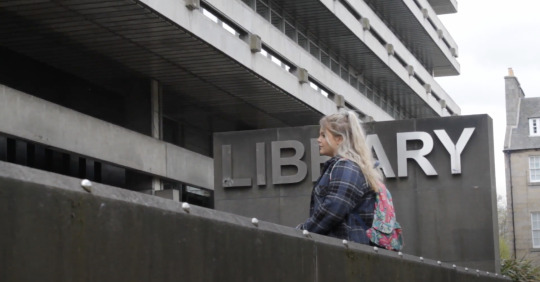
Now that we had our narrative arc in place, we knew what recreations to make. We wanted to recreate instances when Heather was in the Libary, at Edinburgh Castle and Heather at acapella rehearsals. Towards the end of the term, Heather was busy studying for her law exams, so finding time to film proved slightly tricky. However, Emily managed to find an afternoon in which Heather was free to film. Due to Covid constraints and lack of time, I don't think we managed to achieve exactly what we wanted visually with the recreations. But, what we did get was still good and achieved its purpose.
Post-Production:

Once we had all the archive in place, it was time to move on to the grade, After Effects titles and the audio edit. At this point, I took control of the audio edit. Alexander focused on the grade and created titles in After Effects. To do the audio edit, Alexander sent me over the AFF, which he exported from Avid. However, this is when disaster struck. For some reason, when I imported the AFF into PremierPro (which is the only software I have access to edit the sound with, which I know is not ideal), all of the clips were just red, and the sound wasn't working. Alexander and I struggled for a few hours trying to figure out the problem; we emailed Alex at Napier to see if he could help us solve the issues we were having. However, after our best efforts, we couldn't figure it out.
Therefore, the best we could do was export the picture lock as an mp4. One of the main issues with the sound which I was hoping to fix, was the clipping. Because the interview is so chopped up, there are several places where we hear the end of a word or start, which we couldn't cut around because Heather and Emily spoke over each other at times. Also, there were times when all of a sudden, you would hear the sound of cars going by, which I also needed to fix. However, because all the audio tracks had been condensed into an mp4 track, it meant that I couldn't hone in on these instances without running the risk of unsyncing the audio. I tried my best to fix the clipping, but whatever I tried to do in Premier it didn't do anything or made it sound worse. To solve the issue of the street sounds, I tried to create atmos by layering different types of room tone I sourced from FreeSound.com to make the sudden streets sounds sound less sudden. It wasn't a perfect solution, but I think it helped a little bit. After trying to fix the sound, it was time to move onto the soundtrack.
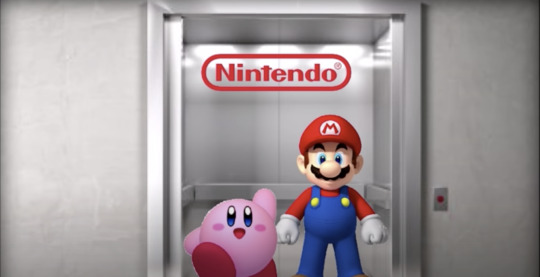
The tone of the interview is quite tricky. Heather talks about her struggles, but she is pretty jovial when she speaks about them. The general tone is quite relaxed and humorous; therefore, traditional soundtracking music didn't seem to work. I talked to Alexander about ideas he had for music, and he spoke about putting some kind of Wii theme under the conversation. Alexander had created funky opening titles and wanted to keep that tone throughout the interview, hence his music suggestion. I spent a whole day scouring the internet, trying to find the right kind of music but struggling as the interview tone is so unique. However, after some time, I managed to find a piece of Wii elevator music that seemed to fit. When Heather speaks about her experience at Edinburgh castle, this is the only time where it gets quite emotional and serious. Therefore, the Wii music didn't work, but I did find a song that highlighted the emotion of sequence. But, the problem was going from the obscure sound of the Wii music to the dramatic sound of Rosie Carney - Awake Me (the song I chose for the castle sequence). For a while, I fiddled with the edit, trying to get the transition right between the two pieces of music without it the change in sound sounding too drastic. I showed my edit to Alexander to see what he thought, and he thought it worked, so that's what we went with. Once I had finished the audio edit, I sent it back over to Alexander. He put everything together and added the finishing touches.
0 notes
Text
Documentary Pre-production:
Interview:
After doing extensive research, the next stage of development was to interview the subject of our documentary, Heather. During our meeting, we discussed Heather's high school experience and how she was labelled a high achiever and was one of only six people in her year who advanced to University. She disscussed how so felt isolated at University; privately educated people surrounded her, and her grades didn't measure up to theirs. She struggled to relate and find friendships as she came from a different world from theirs. The transition from high school to University was challenging, and Heather increasing felt unworthy of her place at Edinburgh University as she compared herself to her peers. Then when she was watching YouTube, she came across the term imposter syndrome. After learning about this term, Heather began to feel more comfortable at University and understood that she wasn't alone in her fears and started to form more meaningful relationships. We asked how the syndrome affected her mentally and did that have a knock-on effect on her studies. Heather said that she felt very isolated and uneducated or dumb in relation to those who are privately educated. And when it is at its worst, she has had anxiety attacks which have caused her to email her lecturers and say that she is quitting. We asked Heather how she deals with these moments when the syndrome becomes overwhelming and if she has any coping mechanisms in place. She told us that she is a part of an acapella group at Napier, which she enjoys, and it helps to take her mind off the stress of University for a little while. And she makes time for her friends because she understands that they are essential, and it's always good to have someone to vent with. To finish off, Heather stated that she had made peace with the syndrome in some way. She understands how it works, and the majority of what she feels is something that has built up her mind, and if she speaks to someone, she understands this. Heather knows that it is not confined to University life and expects to carry it into her professional career, but she will not let it define her or stop her from achieving her goals.
This was not the official interview; it was just a chance for Alexander and I to meet Heather and hear her story from her. The interview was a valuable experience and helped inform how we moved forward.
Preparation for final interview:
After some discussion with Sana, we decided to include Emily in the documentary. As a group, we felt establishing Heathers and Emily's relationship was paramount, especially concerning their shared high school experience. Also, Emily's idea for the documentary came from a conversation Heather had with Emily about Imposter Syndrome, and we wanted to try and capture that in the documentary.
Once this decision had been made, we discussed how the final interview would take shape. We wanted to create a casual interview style because we wanted to establish the relationship between Heather and Emily. Therefore, we decided the interview's premise would be the two of them making drinks and destressing after a long day at University. Due to the interview's casual nature, we felt it wasn't necessary to create questions that Emily could ask but rather a structure of topic areas that Emily could follow. We want the interview to feel as natural as possible and for Heather to feel as comfortable as possible to talk about her experience; therefore, the formal nature of question and answer didn't feel appropriate. Thus, we created a structure to which Emily could refer to when chatting with Heather, so we don't miss anything when we film the interview. This structure includes:
We are dropped into Emily and Heather living room/kitchen as they are making drinks. We are establishing Heather and Emily's relationship.
The pair sit down and discuss University, and they touch on the imposter syndrome.
They reminisce about their high school experience.
The transition from high school to Univerity and discuss the difference between the Baldragon Academy and the private schools her peers went to.
How the imposter syndrome developed from this experience and how it has made her feel.
How Heather copes with the syndrome and what coping mechanisms she has in place, e.g. acapella.
Finally, how Heather has come to understand the syndrome and how it will be a part of her future.
Additionally, we have discussed how to shoot the interview. Due to Covid guidelines, Alexander and I cannot help Emily film. However, she has a bubble with Gordie, another member of the film course who has kindly offered to help us. The interview will have a simple camera set up. A static camera will capture Emily and Heather as they have their chat, and a floating camera, which Gordie will operate, with be used to capture close-ups of Emily and Heather.
Visuals:
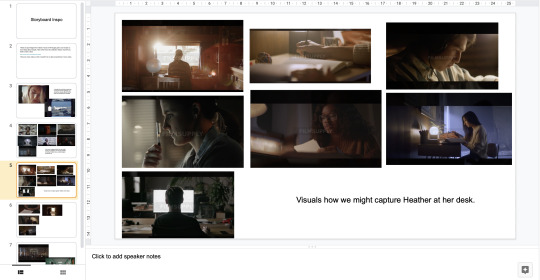
Once we knew the structure that we hoped the interview would take, it was time to think about the documentary's visuals. Emily has a tone of archive footage that we wish to use to establish their relationship and illustrate their high school experience.
The rest of the visuals we are going to use are reconstructions. Firstly, we have permission to film Heather and her acapella group.
Secondly, we want to capture visually what it feels to be overwhelmed by the imposter syndrome. We have created mood boards with examples of similar visuals.
You can find the full document through this link: https://docs.google.com/presentation/d/1_yI5Ltc6BH0s3Uv5r8ONJgCSvupQDpmUvT-75AWe1uE/edit#slide=id.p
The main idea we have currently is how her studies begin to attack her. We will have a lot of imagery at her desk, which is covered in papers and books and perhaps ever have things stuck on the wall. This will illustrate how her studies can become overwhelming. Also, the imagery of her at her desk will be in the daylight and at night to show how it all-encompassing. Once we have established this overwhelming feeling, the imagery at her desk will begin to change; we will include canted angles, close-up and push-ins of her at her desk as though the syndrome is tracking her down.
Additionally, we are going to shoot several different cinematics. Emily and Heather are hopefully going to make a trip down to Edinburgh University and capture some shots down there. These images will be laid over Heather discussing life at University.
We are still developing exciting and dynamic visuals for the documentary but are holding off making any definitive plans until we have the final interview filmed. Therefore, the interview will determine what we film as we will respond to what Heather discusses.
0 notes
Text
Documentary Research:
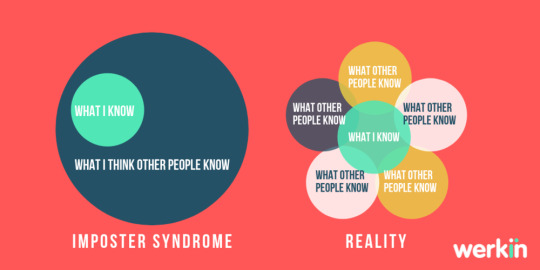
Our documentary is about the imposter syndrome; therefore, our first port of call was to research the syndrome in greater detail.
As a group, we each went off and did our own research, which would help inform our approach to the topic. I found out that imposter syndrome is more than a feeling of anxiety or self-doubt. Someone who deals with it feels like a fraud, they feel like any success they have is due to luck, and they are undeserving of their accolades. The Harvard Business Review description of the syndrome is very eloquent. "Impostor Syndrome is a collection of feelings of inadequacy that persist despite evident success. 'Imposters' suffer from chronic self-doubt and a sense of intellectual fraudulence that override any feelings of success or external proof of their competence."
After this research period, we all felt more prepared going into the next stages of production.
Finding our Focus:
Initially, we wanted to explore the imposter syndrome as a whole, delving into the philological side and gaining a real insight into how the syndrome manifests. And then, we were going to interview several people who have dealt with the syndrome and explore the feeling of exile and isolation the syndrome causes. Then we hoped to bring all the interviewees together, along with the phycologist, and have a round table discussion about the imposter syndrome and convey that these feelings of exile are untrue as many people feel the same way. As a group, we recognised that this idea was unfeasible in the 8 minutes we had for the project; however, this was the style of approach we wanted to take for the documentary.
When trying to find people to interview, we had fantastic access to Emily's friend Heather. Heather was Emily's original inspiration for the project, and Heather was willing to be interviewed. Alexander also spoke to his brother, who is currently studying acting, and mentioned that imposter syndrome was quite prevalent among actors due to embodying characters and method acting. Alexander also said that his lectures had told his brother that he had imposter syndrome and others in his acting classes. Therefore, we had excellent access to another interviewee and potentially others. We noticed a pattern among university students developing the imposter syndrome, which was also backed up by our research which stated that the syndrome is most common amongst academics. Therefore, as students, we had a keen interest in how the syndrome affected and developed in university students.
However, this plan kind of fell apart; before our treatment were still gathering interviewees and toying with the idea of making the documentary solely about Heather. When we mentioned this in class, Sana told us that we did not have enough people to interview, and it would be in our best interests to do the documentary on Heather. After class, we discussed the project and decided to move forward, focusing on Heather's story. At the time, Heather was not entirely comfortable having the whole documentary about herself; however, Emily spoke with her several times, and Heather came round to the idea.
Having decided the documentary would be about Heather, we scheduled a meeting with her as Alex, and I had not met her yet. This meeting went well; it was a very informal chat to discuss several topics we thought we might cover in the documentary. From the interview, we found out some very interesting things. Firstly, Heather disscussed her transition from high school to university, where she recognised imposter syndrome development. Heather went to Baldragon Academy, which was ranked one of the top ten worst high schools in Scotland. At school, she was considered a gifted and high achieving student, having achieved A's in her advanced highers and was only six people in her year to go to university. After high school, Heather went to Edinburgh University to study law, one of the most prestigious courses and was plunged into a world full of privately educated people and immediately felt inferior. She felt like a fraud because when it came to uni assessments, she was getting C's and her peers were achieving A's and felt her place on the course was undeserved. However, one day, Heather watched a YouTuber who was also a law student, and they discussed the term imposter syndrome, which is how she first found out about it. Heather mentioned how overwhelming the syndrome can feel, and she suffers from anxiety. On several occasions, she has gotten to the point where she has emailed her lecture to say she is quitting the course because the feeling of indecency have gotten so bad. She talked about extracurricular activities she does to help distract from university pressure, including singing in an acapella group. From the interview, we gained a lot of insight. But I could tell Heather wasn't too comfortable delving too deep into some of the more personal aspects of our conversation, which only to be expected as it is the first time we have met Heather, and she bound to be nervous. Therefore, we need to have future follow up interviews to make Heather more comfortable in our presence.
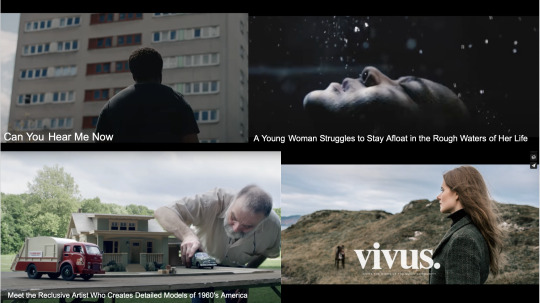
Additionally, we have looked at other short documentaries to help inspire our stylistic approach to the documentary. The ones which I found and watched include:
Meet the Reclusive Artist Who Creates Detailed Models of 1960's America: https://www.youtube.com/watch?v=VvRWx51Cbyc&list=LL&index=3. What I liked most about this documentary was the way it incorporated its archive images. They are placed amongst the models, denoting that they are part of the artwork because his experiences have influenced his art.
A Young Woman Struggles to Stay Afloat in the Rough Waters of Her Life: https://www.youtube.com/watch?v=_F-QmEqmAVU&list=LL&index=4 What was most influential in this documentary was the way the film depicted what it felt like to have depression. Therefore, the films visual language was impressive in this film and gave us a lot to think about when it comes to our approach.
Can You Hear Me Now: https://www.youtube.com/watch?v=PB86pd_VRgc&list=LL&index=6&t=104s This documentary gave me a lot of inspiration when it came to interviewing approach. It isn't a standard question-answer interview; it's more of a traditional style of the interview, which has then been rewritten into a form of lyrical prose which the interviewee reads aloud. And I thought the camera style of the interview matched perfectly with the narrative arc of the interview. At the begging, we only see the man mouth or the top of his head, and as the narrative progresses and the narrator lets us in more, the more we see of the narrator.
Virus: Inside the minds of the music community: https://vimeo.com/250953592 Similarly to Can You Hear Me, this documentary gave me a lot of inspiration in terms of visuals and interview approach. Especially in terms of capturing B-roll and recreating element, such as when the interviewee is writing songs or playing music.
There have been many others that I have watched during my research processes, but these four were the most influential.
Moving forward, as a group, we need to bring all the research we have done together and start to create a more formalised plan and approach to how we plan on filming and editing the documentary. This means creating some form of storyboards, schedule and interview method.
0 notes
Text
Voiceover, Archive and Structures - Thoughts on Documentaries:
Shoah:

The way the documentary used testimony was interesting, and I think it provided a different aspect of the use of the archive footage. Taking the survives of the Holocaust to the camps in which they escaped from had a two-pronged effect for me. Firstly, I felt like I was intruding on a very personal experience. Many people returning to a place where a horrific event took place can be a process of closure for some people, a way to heal and confront the past. Therefore, watching this man on his journey felt like I had been given the wrong invitation. However, this technique made me think about the use of archive footage in a way I had never done before. Archive footage is used to show viewers the truth of an event because the camera cannot lie; however, there is controversy in this statement, but this is not the point. When discussing events such as the holocaust archive footage is used to shock its audience and show the pain and suffering innocent people had to go through. By shocking, the audience demonstrates how this must not be allowed again. Although through the education of the Holocaust, the population may have become desensitised with the horrors that occurred, and I think, achieve footage places the attention and fascination of the footage with the Nazis. Therefore, removing archive footage, our attention is on the victims and gives a voice to the footage's nameless faces, which is where it should be instead of focusing on the actions of the Nazis. The same argument is made when concerning serial killers; there is a common tread to romanticise the killer's actions and fixate on their psychology, and the victims become an afterthought.
Night and Fog:
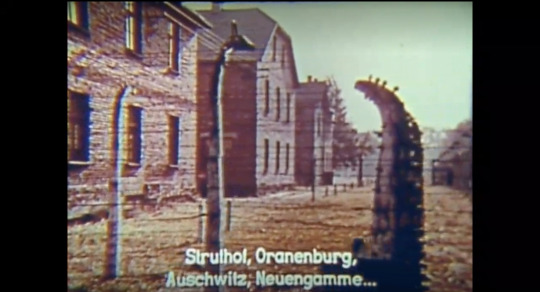
Unlike 'Shoah' 'Night and Fog' use voice over and archive to create its narrative. To me, the film felt like a bog juxtaposition. Firstly, the music has this sort of rhythmic twang to it which conflict with the starkness of the images. The voiceover is delivered in a very matter of fact way but was almost poetic with its use of amelioration. For example, it mentions how the sun now shines on the tracks that once brought the Jew to the concentration camps. For me, this use of juxtaposition gave the documentary an angry edge amidst its lyrical tone. The documentary was a decade after the war ended, and I think it highlights how the world has moved on so quickly. For example, when it mentions how the sun shines on the tracks, it felt almost accusatory. However, as I write about it, maybe it's a good thing that the light shines on the tracks because the horrors of the Holocaust have been brought to light. But, I think this mixed metaphor demonstrates that it is a complicated issue, about how to remember the tragedy of the event and how we move forward as part of our history. Furthermore, Night and Fog uses archive footage to authenticate the footage they have captured of the abandoned concentration camps. To state that these train tracks were used to transport people to their death and even though they lay silent now, their history should not be forgotten.
37 Uses for a Dead Sheep:

This film uses the combination of testimony and reenactment to tell its story. The film is about a community which were forced to leave their home and settle in Turkey. The filmmaker collaborates with people who live in the village to create the film and uses a mixture of testimony and reenactments to tell its story. When discussing this film, the main talking point is about the ethics of this type of filmmaking—compared to say 'Nanook of the North', which had recreations that included actors who were not apart of the Inuit community and is said to be inaccurate in its depiction of events. However, I think the recreations created in 37 Uses for a Dead Sheep is on the right side of ethical filmmaking. Firstly, the Director uses a reflexive method and explains his process and that he will be working with the community to create the reenactments, which, of course, authenticates them. Secondly, the film is not a sting of reenactments and includes testimony. The testimonies, paired with the reenactments, gives a personal element to the documentary and as they preceded the reenactments and furthers their authenticity.
0 notes
Text
Thoughts on Representing the Real Documentaries.
Chronicle of a summer:

I thought this film was interserting, especially when the filmmakers decided to include themselves and when not to. In the first instance, we see the filmmakers interviewing Marceline; they have included themselves and are showcasing the process of filmmaking in true cinema verite fashion. They make clear at the start of the film that Marceline is its subject, and we see her growth as she becomes more natural and comfortable in front of the camera. But as Marceline grows, the filmmaker's approach differs also. They address the gap between reality and the representation of reality, through their first interview with Marceline. More often than not, interviews are talking heads, and the interviewer becomes non-existent, the interviewee asks and answers their questions. However, having the interviewer in front of the camera brings awareness to the documentary's orchestrated nature. But as the film progresses, the filmmaker becomes less of an element within the film. They offer up a point of discussion at the table, but it is the people who are sat at the table that create conversation. In the last section of the clip, Marceline is seen by herself talking honestly about her experience during the war. These emotions are felt more profoundly because of the way this sequence is shot and created using a particular setting. Therefore, this section is more like direct cinema; perhaps; it uses traditional forms of film language which can be seen in fictional filmmaking. This mixture of filmmaking styles addresses the gap between reality and representation. I think they can justify the orchestrated nature of Marceline's storytelling by the inclusion of themselves earlier on in the film as they have addressed the controversy of documentary storytelling.
The Thin Blue Line:

In this discussion, I'm not sure I totally understand the use of reflexive filmmaking in this documentary, but this is what I got from it. From the clip in the lecture, I felt that if I watched the documentary in its entirety, it would make a statement about perceptions and reenactments. If I have understood correctly reflexive documentary, the documentary's process is made clear and reflected upon. Through its use of reenactment and talking heads, demonstrates how the facts of an event can be distorted from different viewpoints. And in this way, the filmmaker clarifies the downfalls of the police investigation and reflects how the situation could have turned out differently if some aspects of the case were different. For example, if the female officer had followed protocol, she would have been better positioned to help her partner. Overall, I found it fascinating hearing the story told by the police and the those who were convicted. For instance, when Randall Adams describes who the police were trying to coerce a confession out of him and trick him into putting his prints of the murder weapon. This is then juxtaposed by talking heads officers who recount the evidence and the facts of the case to justify why they don't want to be blamed for Adams false imprisonment. This is definitely a documentary which I want to seek out and hopefully see in full.
0 notes
Text
Documentary Film Introductory Lecture:
The discussion in class concerning home, exile and memory helped start coming up with ideas and how to approach the topic. When we were placed in breakout rooms, our group had some fascinating discussion and gathered some ideas.
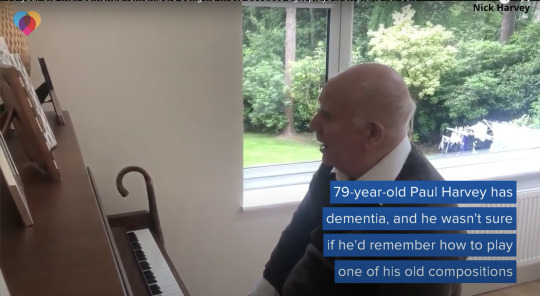
In terms of memory, we discussed dementia and how the disease distorts memory. For example, people who suffer through dementia often have difficulty with short-term memory and forget names of loved ones or forget conversations they had recently. However, there are many cases where people with dementia have vivid memories about their childhood and can recount it in detail. For instance, recently in the news, Paul Harvey, a man who has dementia, is a retired composer and can correctly remember compositions he has created but struggles to recall aspects of his memory. We thought this would be an instructing avenue to go down and discover how it feels to have memory betray you in this way.

Another idea which we had in terms of memory is the phenomenon of the Mandela effect. This theory came about when thousands of people shared the same concusses that Mandela had died in prison and was shocked to find out this wasn't true. And since there have been other instances, such as above, thousands of people believe that the monopoly man wears a monocle, this is false. This would be an exciting documentary topic to explore how memory works not just individually but on a broader scale and how something like the Mandela effect can come to be.

We also discussed the theory of six degrees of separation. The theory states that you are only six connection away from anyone in the world. After Tom told us about his fixation about trying to find the contact information for Clint Eastwood, the discussion came about. We came up with the idea for subverting the notion of exile to prove that perhaps we not as secluded as we might think. Therefore, the documentary would take a more lighthearted approach to find a famous personality and test the six degrees of separation theory.
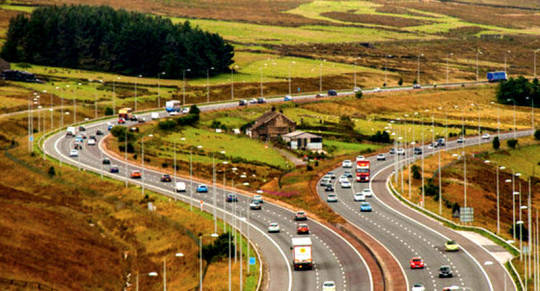
This is not an idea that was brought up during class discussion but which has come to mind recently. There is a house in Manchester which lies in the middle of the M62. The owner refused to sell and make way for the new motorway so they had to build around the house. I thought it would be interesting to discover what home means to this family and why they felt they couldn't create a home elsewhere.
0 notes
Text
The Great Ecstasy of the woodcarver Steiner:

The documentary looks into Walter Steiner'sSteiner's physiology, an accomplished ski-flyer who is at the top of his profession. Being at the top for Steiner is an exciting paradigm; he is adored by people worldwide for his impressive skill; however, he experiences isolation due to exceptional talent. Steiner is pushed, perhaps by those less informed than himself, to do jumps and test boundaries which he is not comfortable with. The exile he feels causes him extreme frustration as he has proven time and time again his prowess in the sport but when he brings up his concerns about the sport he is ignored by officials and his word seems to count for nothing.
The whole film seems to flirt with this idea of the two sides of the same coin or a double-edged sword. Steiner is heralded as a star of the sport; however, his knowledge is undermined when he wishes to confront those in charge. He wants to effect change within the sport to help make it safer but is seen as a successful athlete who has thoughts above his station. In the film we see Steiner in his isolation, he is competing at an entirely different level as his peers, he is surrounded by fans and reports who want the chance to say hi or get a quick interview but do not care to exchange with him but want to say that they have met the most famous ski-flyer in the world. I think the film plays with the exciting idea of fame and how it creates isolation; when a person becomes famous for something they become known by so many people worldwide, they function differently in society. In comparison to the worldwide population, only a small handful of people are known and loved by thousands and thousands of people; therefore, they are propelled to a higher place in society and become isolated.
The imagery in the film is breathtaking and clearly illustrates the double-edged nature of the subject matter. One moment you can feel at one with nature as you sore through the air and then in the blink of an eye, you could be hurtling down a hill at inhuman speed after a poor landing. It cuts to the core of Walter Steiner'sSteiner's frustration as it demonstrates the danger he is putting himself in and as he puts it "do I have to break my skull before they start to listen to me".
Overall, I thought the film was profound and exciting it wasn't just about the success of an accomplished ski-flyer but how success can be a lonely thing.
0 notes
